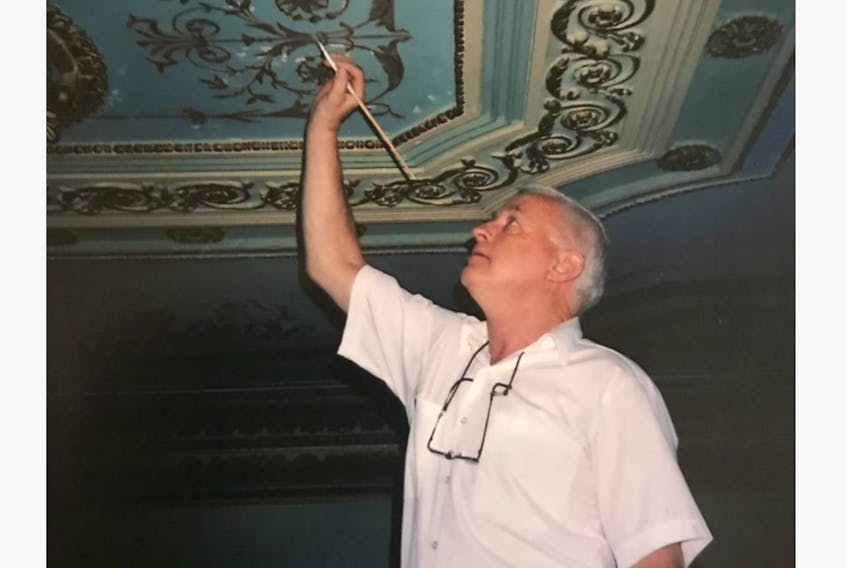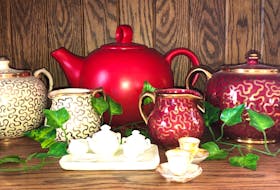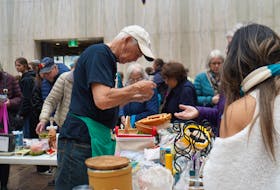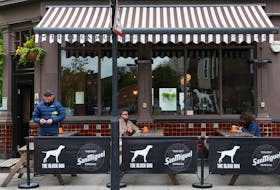ST. JOHN'S, N.L. — Jerome Conway’s brilliant hands left their mark on the luxurious ceilings and walls of the most historically prominent buildings and homes in St. John’s, but he is remembered as a humble man who would never boast of his art.
He was one of the generations of Conway master plasterers renowned for their craftsmanship and restoration work.
“He would talk to anybody who asked, but he would never bring it up,” said Conway’s daughter, Karen Gill. “Dad was never one to entertain a crowd, never, never, never. He was very unassuming, always in the background. His brothers were exactly like that... They did great work and were very proud of it, but kept it to themselves.”
Jerome Conway died this week at age 73, from pancreatic cancer.

In the 1990s, after deciding to discontinue the business after deaths among the craftsmen family, Conway went to work for the Janeway as a plasterer and took the same pride in that job as he did in the complicated restoration he had done at the Basilica, the Colonial Building and Government House.
(The original Government House ceilings were crafted by Polish fresco painter Alexander Pindikowsky, who was convicted of forgery and worked on the Colonial Building next door.)
The Conway craftsmen were so renowned, Gill said, that saying the last name over the years to people prompted the frequent query, “Conway? You’re not from the plasterers’ crowd are you?”
Retired Government House manager Ron Ershler remembers the Conway plasterers as polite, knowledgeable and beyond compare in modern times.
“There’s no workmanship that’s around now that anyone can say ‘I can fix that’ like they did,” Ershler said. “Personally, for me, I have never seen anybody like it.”
“There’s no workmanship that’s around now that anyone can say ‘I can fix that’ like they did." — Ron Ershler
Ershler recalls seeing Conway and his brothers lying on their backs on high scaffolding trying to perfectly match colours on the Government House ceiling after repairing the ornate plaster features. They mixed dozens of different shades until they got the perfect colour.
One of the jobs involved replicating hard plaster work, including rosettes and other architectural features, after there was an issue with the beams, Ershler said. All the work was done by hand using special moulds they created.
And Ershler said when the Conways put it all back together, it was historically precise.
During the five years Ed Roberts was Lieutenant Governor, the Conways were in several times to do repair and maintenance work.
“It fitted in superbly... Unless you really knew, you couldn’t tell one from the other. It’s the end of a long tradition. It’s a loss,” Roberts said.

None of the younger generation have taken up the profession, Gill said.
But the family retains joy in seeing the handiwork in the most prominent public addresses.
“Oh my gosh, it makes me tremendously proud. Our kids will always know Poppy did this, he had his hands on this, that he helped create and make beautiful buildings,” she said.
The tradition of the Conways spanned five generations in Newfoundland and Labrador, according to Jerome’s brother, Noel, who didn’t go into the master plasterer trade with his brothers, but has a keen appreciation for his family’s legacy.
Plasterer/slater Denis Conway immigrated from Ireland to Cole Harbour, N.S., in 1820. He and his family came to St. John’s in 1847 so he could work on the Basilica.
"Our kids will always know Poppy did this, he had his hands on this, that he helped create and make beautiful buildings." — Karen Gill, Conway's daughter
According to “The Story of the Basilica of St. John the Baptist” by Susan Chalker Browne, Archbishop Michael Anthony Fleming insisted on a slate roof, even after Denis told him it was too heavy. Fleming’s successor, John Thomas Mullock, listened to Denis, as the roof was sagging dangerously on the beams that were not strong enough to support it.
The next generation of the Conways were also responsible for the Basilica’s Italianate plaster ceiling — working with wood carver Dan Carroll and architect Jonas Barter — and they installed the five elaborate pendant drops decorated with cherubs.
Years later, Jerome, repairing a broken horn on the statue of St. Luke, honoured a craftsmen tradition of placing a note in a hidden place with his name on it, and found a note with his father John’s name already there, Noel said.
Other public buildings they did restoration work on included Commissariat House, the Confederation Building and the Supreme Court building.

Among the private homes the Conways worked on was Joey Smallwood’s on Roache’s Line.
Noel recalled Jerome recounting a story of how Smallwood wanted to try to have John Conway knighted by the Queen of England on one of her visits, and Jerome wanted no part of it because of his modesty.
The Conway brothers who continued the work of their father, John — Jerome, Gus, Charles and Jerry — also etched their names on the lips of restored features of the elaborate Colonial Building ceiling — in spots unseen to the public eye, but visible to future craftsmen.
The Conways were known for dressing in pristine whites and even in ties and newsboy caps.
Away from his craft, Noel Conway remembers Jerome as always active, loving dancing, skating, salmon fishing and life in general.
To Karen Gill and her sister, Cindy, Jerome Conway was a dad who epitomized the words family man.
“He was an extremely hands-on dad, moreso before his time,” Gill said.
To his grandchildren, she said, “Poppy was king.”
“Poppy was king.” — Gill
He was a collector of many things — from stamps and coin to tools and historical artifacts and bottles spanning every beverage, even though he never took an alcoholic drink.
He was also a fixer who would quietly repair things at his daughter’s home and never mention it until she happened to notice a tap was no longer leaking or a door handle was tightened.
And he helped his neighbours in east-end St. John’s with chores like snowclearing and was always up for a friendly chat, to the point one young man recounted to Gill that he sometimes lost track of time and was late for work after stopping to talk with Conway.
“So many neighbours have reached out to say, ‘Oh my God, what a blow,” Gill said.
As Conway fought cancer, his wife, Sheila, whom he doted on, was foremost on his mind.
“His last worries and concerns were all based on Mom and making sure she would be OK,” Gill said.
Want to join the conversation? Comments are open on this article at SaltWire.com
Twitter: @BarbSweetTweets









